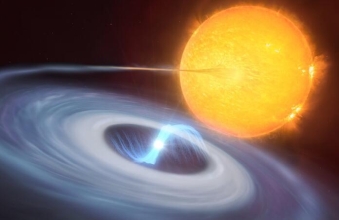  A kilonova is a burst of electromagnetic radiation that results from the radioactive decay of iron atoms in material ejected when two neutron stars smash together, or when a neutron star merges with a black hole.
A kilonova is a burst of electromagnetic radiation that results from the radioactive decay of iron atoms in material ejected when two neutron stars smash together, or when a neutron star merges with a black hole. When these collisions occur, a vast amount of material is ejected from the neutron star(s), the ultradense cores of massive stars that have reached the ends of their lives. This matter, up to a few percent of the colliding masses, is rich in neutrons, and in the dense and reactive sea of particles surrounding the bodies, the heaviest elements of the periodic table are created. These include gold, iodine and platinum, and radioactive materials such as uranium. A kilonova is the radiation, mostly optical light, emitted by this ejected material, which appears in the sky as a brief flash of light that peaks and then fades, before completely disappearing.  When spiraling neutron stars finally collide and merge, this creates a sudden blast of gravitational waves that can be detected when they finally reach Earth. This telsl us that a merger of massive neutron stars has occurred. Astronomers then attempt to find its corresponding kilonova in the sky. This is enormously challenging, as they are faint and rapidly fading. So far, only one definitive event has been identified, observed with large telescopes, and monitored spectroscopically so that we can determine its composition, geometry and velocity.
When spiraling neutron stars finally collide and merge, this creates a sudden blast of gravitational waves that can be detected when they finally reach Earth. This telsl us that a merger of massive neutron stars has occurred. Astronomers then attempt to find its corresponding kilonova in the sky. This is enormously challenging, as they are faint and rapidly fading. So far, only one definitive event has been identified, observed with large telescopes, and monitored spectroscopically so that we can determine its composition, geometry and velocity. This worked amazingly well in 2017, when scientists detected gravitational waves from a merger of neutron stars located 130 million light-years from Earth. Within 12 hours, the source of the gravitational wave signal was found to be in the galaxy NGC 4993, and the kilonova resulting from the merger had been spotted in observations made by the Hubble Space Telescope. This was the first event to be 'heard' in gravitational waves and 'seen' with electromagnetic radiation. Kilonovas were initially referred to as mini-supernovas or 'micronovas', since the radiation flashes of neutron stars merging were predicted to be between 1% and 10% as bright as those from typical supernovas. Although a kilonova is less powerful than a supernova, it is still 1,000 times more powerful than a standard nova.  A standard nova (right) happens when a dim stellar corpse called a white dwarf in a binary system pulls matter from its companion star, usually a red giant, causing the white dwarf to suddenly brighten to thousands of times its original luminosity. When this material accumulates on the surface of the white dwarf, it triggers a nuclear explosion that ejects stellar material. The white dwarf begins accumulating matter again from the red giant, and the process repeats.
A standard nova (right) happens when a dim stellar corpse called a white dwarf in a binary system pulls matter from its companion star, usually a red giant, causing the white dwarf to suddenly brighten to thousands of times its original luminosity. When this material accumulates on the surface of the white dwarf, it triggers a nuclear explosion that ejects stellar material. The white dwarf begins accumulating matter again from the red giant, and the process repeats. A Type Ia supernova is similar to a standard nova in that a white dwarf strips matter from a binary companion. But in this instance, that flow of material pushes the white dwarf over the mass limit needed to trigger a supernova and the creation of a neutron star. Type II supernovas also indicate the birth of a neutron star or a black hole. In this case, however, that occurs as the result of the collapse of the core of a massive star at the end of its lifetime. For this reason, these cosmic explosions are often called 'core collapse' supernovas, which are more than a million times brighter than novas.These events can also create periodic table elements heavier than iron. Since both types of supernova produce neutron stars, the creation of kilonovas require that a supernova explosion or two have happened first in the same stellar system, although the explosive events are likely separated by billions of years. |